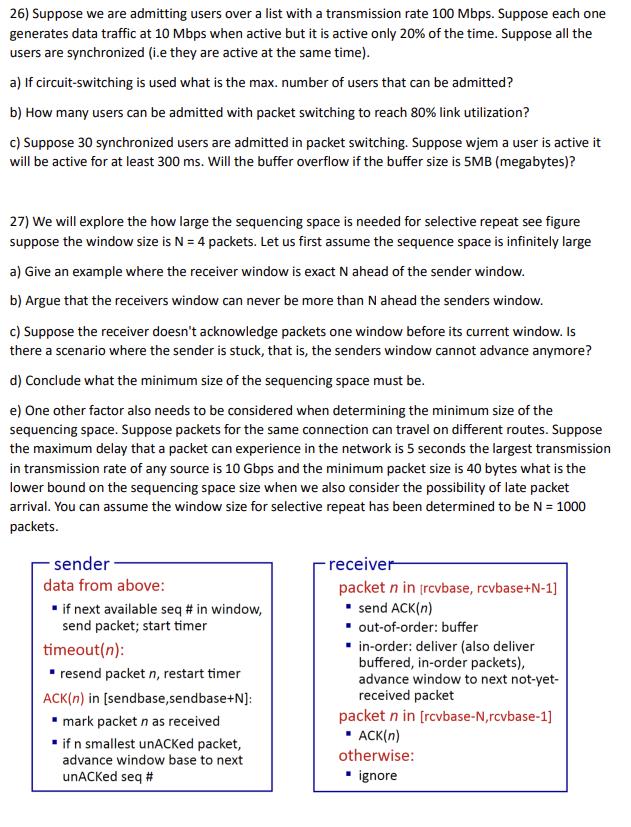Answered step by step
Verified Expert Solution
Question
1 Approved Answer
26) Suppose we are admitting users over a list with a transmission rate 100 Mbps. Suppose each one generates data traffic at 10 Mbps

26) Suppose we are admitting users over a list with a transmission rate 100 Mbps. Suppose each one generates data traffic at 10 Mbps when active but it is active only 20% of the time. Suppose all the users are synchronized (i.e they are active at the same time). a) If circuit-switching is used what is the max. number of users that can be admitted? b) How many users can be admitted with packet switching to reach 80% link utilization? c) Suppose 30 synchronized users are admitted in packet switching. Suppose wjem a user is active it will be active for at least 300 ms. Will the buffer overflow if the buffer size is 5MB (megabytes)? 27) We will explore the how large the sequencing space is needed for selective repeat see figure suppose the window size is N = 4 packets. Let us first assume the sequence space is infinitely large a) Give an example where the receiver window is exact N ahead of the sender window. b) Argue that the receivers window can never be more than N ahead the senders window. c) Suppose the receiver doesn't acknowledge packets one window before its current window. Is there a scenario where the sender is stuck, that is, the senders window cannot advance anymore? d) Conclude what the minimum size of the sequencing space must be. e) One other factor also needs to be considered when determining the minimum size of the sequencing space. Suppose packets for the same connection can travel on different routes. Suppose the maximum delay that a packet can experience in the network is 5 seconds the largest transmission in transmission rate of any source is 10 Gbps and the minimum packet size is 40 bytes what is the lower bound on the sequencing space size when we also consider the possibility of late packet arrival. You can assume the window size for selective repeat has been determined to be N = 1000 packets. -sender- data from above: if next available seq # in window, send packet; start timer timeout(n): resend packet n, restart timer ACK(n) in [sendbase, sendbase+N]: mark packet n as received if n smallest unACKed packet, advance window base to next unACKed seq # receiver packet n in [rcvbase, rcvbase+N-1] send ACK(n) out-of-order: buffer in-order: deliver (also deliver buffered, in-order packets), advance window to next not-yet- received packet packet n in [rcvbase-N,rcvbase-1] ACK(n) otherwise: ignore
Step by Step Solution
★★★★★
3.39 Rating (158 Votes )
There are 3 Steps involved in it
Step: 1
The detailed answer for the above question is provided below 26a If circuitswitching is used the maximum number of users that can be admitted is determined by the available bandwidth and the data rate ...
Get Instant Access to Expert-Tailored Solutions
See step-by-step solutions with expert insights and AI powered tools for academic success
Step: 2

Step: 3

Ace Your Homework with AI
Get the answers you need in no time with our AI-driven, step-by-step assistance
Get Started


